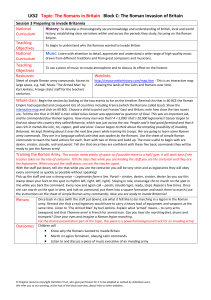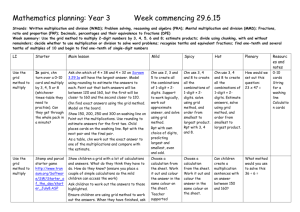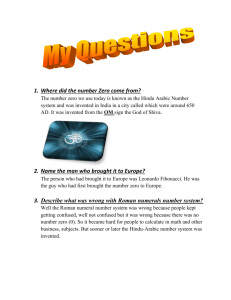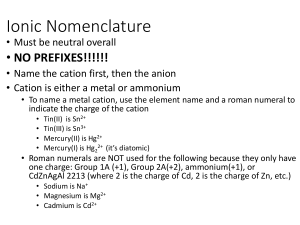Summer Week 1 Plan
advertisement
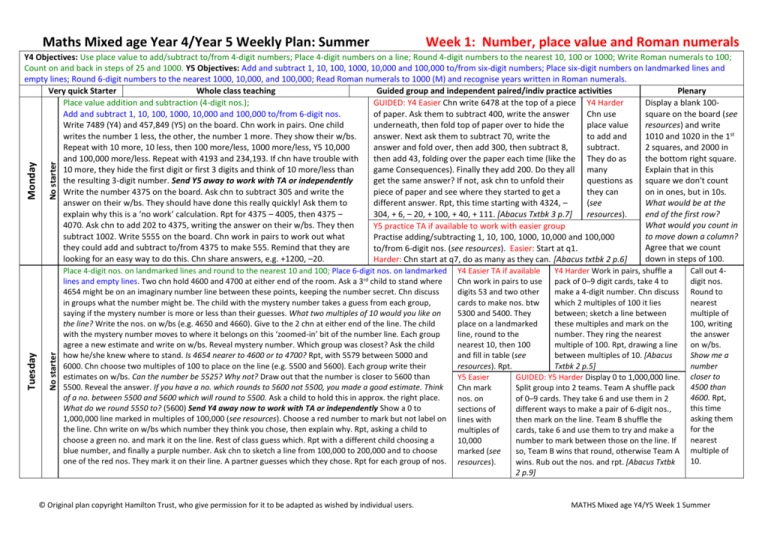
Maths Mixed age Year 4/Year 5 Weekly Plan: Summer Week 1: Number, place value and Roman numerals No starter No starter Tuesday Monday Y4 Objectives: Use place value to add/subtract to/from 4-digit numbers; Place 4-digit numbers on a line; Round 4-digit numbers to the nearest 10, 100 or 1000; Write Roman numerals to 100; Count on and back in steps of 25 and 1000. Y5 Objectives: Add and subtract 1, 10, 100, 1000, 10,000 and 100,000 to/from six-digit numbers; Place six-digit numbers on landmarked lines and empty lines; Round 6-digit numbers to the nearest 1000, 10,000, and 100,000; Read Roman numerals to 1000 (M) and recognise years written in Roman numerals. Very quick Starter Whole class teaching Guided group and independent paired/indiv practice activities Plenary Place value addition and subtraction (4-digit nos.); GUIDED: Y4 Easier Chn write 6478 at the top of a piece Y4 Harder Display a blank 100Add and subtract 1, 10, 100, 1000, 10,000 and 100,000 to/from 6-digit nos. of paper. Ask them to subtract 400, write the answer Chn use square on the board (see Write 7489 (Y4) and 457,849 (Y5) on the board. Chn work in pairs. One child underneath, then fold top of paper over to hide the place value resources) and write writes the number 1 less, the other, the number 1 more. They show their w/bs. answer. Next ask them to subtract 70, write the to add and 1010 and 1020 in the 1st Repeat with 10 more, 10 less, then 100 more/less, 1000 more/less, Y5 10,000 answer and fold over, then add 300, then subtract 8, subtract. 2 squares, and 2000 in and 100,000 more/less. Repeat with 4193 and 234,193. If chn have trouble with then add 43, folding over the paper each time (like the They do as the bottom right square. 10 more, they hide the first digit or first 3 digits and think of 10 more/less than game Consequences). Finally they add 200. Do they all many Explain that in this the resulting 3-digit number. Send Y5 away to work with TA or independently get the same answer? If not, ask chn to unfold their questions as square we don't count Write the number 4375 on the board. Ask chn to subtract 305 and write the piece of paper and see where they started to get a they can on in ones, but in 10s. answer on their w/bs. They should have done this really quickly! Ask them to different answer. Rpt, this time starting with 4324, – (see What would be at the explain why this is a ‘no work’ calculation. Rpt for 4375 – 4005, then 4375 – 304, + 6, – 20, + 100, + 40, + 111. [Abacus Txtbk 3 p.7] resources). end of the first row? 4070. Ask chn to add 202 to 4375, writing the answer on their w/bs. They then What would you count in Y5 practice TA if available to work with easier group subtract 1002. Write 5555 on the board. Chn work in pairs to work out what to move down a column? Practise adding/subtracting 1, 10, 100, 1000, 10,000 and 100,000 they could add and subtract to/from 4375 to make 555. Remind that they are Agree that we count to/from 6-digit nos. (see resources). Easier: Start at q1. looking for an easy way to do this. Chn share answers, e.g. +1200, –20. down in steps of 100. Harder: Chn start at q7, do as many as they can. [Abacus txtbk 2 p.6] Place 4-digit nos. on landmarked lines and round to the nearest 10 and 100; Place 6-digit nos. on landmarked Y4 Easier TA if available Y4 Harder Work in pairs, shuffle a Call out 4lines and empty lines. Two chn hold 4600 and 4700 at either end of the room. Ask a 3rd child to stand where Chn work in pairs to use pack of 0–9 digit cards, take 4 to digit nos. 4654 might be on an imaginary number line between these points, keeping the number secret. Chn discuss digits 53 and two other make a 4-digit number. Chn discuss Round to in groups what the number might be. The child with the mystery number takes a guess from each group, cards to make nos. btw which 2 multiples of 100 it lies nearest saying if the mystery number is more or less than their guesses. What two multiples of 10 would you like on 5300 and 5400. They between; sketch a line between multiple of the line? Write the nos. on w/bs (e.g. 4650 and 4660). Give to the 2 chn at either end of the line. The child place on a landmarked these multiples and mark on the 100, writing with the mystery number moves to where it belongs on this ‘zoomed-in’ bit of the number line. Each group line, round to the number. They ring the nearest the answer agree a new estimate and write on w/bs. Reveal mystery number. Which group was closest? Ask the child nearest 10, then 100 multiple of 100. Rpt, drawing a line on w/bs. how he/she knew where to stand. Is 4654 nearer to 4600 or to 4700? Rpt, with 5579 between 5000 and and fill in table (see between multiples of 10. [Abacus Show me a 6000. Chn choose two multiples of 100 to place on the line (e.g. 5500 and 5600). Each group write their resources). Rpt. Txtbk 2 p.5] number estimates on w/bs. Can the number be 5525? Why not? Draw out that the number is closer to 5600 than Y5 Easier GUIDED: Y5 Harder Display 0 to 1,000,000 line. closer to 5500. Reveal the answer. If you have a no. which rounds to 5600 not 5500, you made a good estimate. Think 4500 than Chn mark Split group into 2 teams. Team A shuffle pack of a no. between 5500 and 5600 which will round to 5500. Ask a child to hold this in approx. the right place. 4600. Rpt, nos. on of 0–9 cards. They take 6 and use them in 2 What do we round 5550 to? (5600) Send Y4 away now to work with TA or independently Show a 0 to this time sections of different ways to make a pair of 6-digit nos., 1,000,000 line marked in multiples of 100,000 (see resources). Choose a red number to mark but not label on lines with asking them then mark on the line. Team B shuffle the the line. Chn write on w/bs which number they think you chose, then explain why. Rpt, asking a child to for the multiples of cards, take 6 and use them to try and make a choose a green no. and mark it on the line. Rest of class guess which. Rpt with a different child choosing a nearest 10,000 number to mark between those on the line. If blue number, and finally a purple number. Ask chn to sketch a line from 100,000 to 200,000 and to choose marked (see so, Team B wins that round, otherwise Team A multiple of one of the red nos. They mark it on their line. A partner guesses which they chose. Rpt for each group of nos. resources). 10. wins. Rub out the nos. and rpt. [Abacus Txtbk 2 p.9] © Original plan copyright Hamilton Trust, who give permission for it to be adapted as wished by individual users. MATHS Mixed age Y4/Y5 Week 1 Summer Maths Mixed age Year 4/Year 5 Weekly Plan: Summer Thursday Wednesday Very quick Starter Whole class teaching Week 1: Number, place value and Roman numerals Guided group and independent paired/indiv practice activities Plenary Count on Place four-digit numbers on landmarked lines (marked in 1000s) and round to Y4 Easier Y4 Harder during Y5 teaching Give out 1000s cards 10s from 4the nearest 1000; Round six-digit numbers to the nearest 1000, 10,000, and Chn work in pairs to Chn work in pairs to shuffle a pack of 0–9 digit to pairs around the digit nos. & 100,000. Show chn a 0–10,000 line marked in 1000s, and three nos. marked but use 5 and three cards, and take 4 to make a 4-digit number. class so that each pair back not labelled (see resources). Point out the first number marked on the line and other cards to make They discuss which 2 multiples of 1000 it lies has one card. (Give Y4 Together ask chn to guess which of the six nos. written underneath the line it might be. a 4-digit number between; sketch a line between the 2 multiples easier group 5000 or count in 10s Do you think it’s 2379 or 2739? Why? Draw out that the mark is closer to 2000 between 5000 & of 1000 and mark on the number. They ring the 6000.) Use a random from 5923 than 3000 so the number must be 2379. 2379 rounds to 2000 if we round to 6000, and place on a nearest multiple of 100. GUIDED: Y4 Harder Ask number generator: to at least the nearest 1000. Rpt with the other two marks. Draw out which multiple of landmarked line (see each pair of chn to shuffle a pack of 0–9 cards http://www.primaryre 6123 and 1000 is closer to each. Send Y5 away now to work with TA or independently resources). They and take 4 cards. Shuffle a pack of 1000s cards sources.co.uk/maths/f back again. Sketch a line on the board from 200,000 to 300,000. A child thinks of a number round to the nearest (e.g. from place value cards) and show one to lash/Bingo.swf to Now count between the two and marks it on the line but doesn’t write the number. Chn 1000. They write, the group. If a pair of chn can use their 4 digit generate nos. in 10s round discuss and write an estimate on their w/bs. They choose two multiples of e.g. 5437 rounds to cards to make a number which rounds to this between 1000 and the class 10,000 for the ends of a new line. Draw this new line underneath and the child 5000. Rpt. multiple of 1000, they win a point. Rpt. 10,000. Chn round to from 2867, marks the same number on this ‘zoomed-in’ section of the line. Chn revise their Y5 Practice the nearest 1000. If then back estimates, then agree two multiples of 1000 for new ends of a line. The child it’s the number on Chn round the population of islands to the nearest 100,000, then again. Rpt, marks the number. Chn revise estimates again. The child reveals the mystery their card, they hold 10,000, then 1000 (see resources). Suggest they draft number lines and starting in a number and labels it on each line. Round it to the nearest 100,000, 10,000 then mark the populations on them to help them to round if necessary. up the card and earn a diff. place. 1000. Rpt with a new child and a line between 500,000 and 600,000. point. Rpt. Easier TA Chn place on a landmarked line to help (see resources). Count History of zero and place value; Roman numerals to 100; Roman numerals to 1000 (M). Y4 investigation Ask Y4 chn in 6s Write the numerals 0 to 9 on the board and point out how these numerals can be used to write any number that we Chn work in pairs to choose a times table, and to to compare Count can think of, from tiny nos. to huge nos. Show a picture of a clock with Roman numerals (see resources). Explain that write it out using only Roman numerals. They using round all nos. used to be written like this! Point out how 9, 11 and 12 are written. Challenge chn to figure out how to write write just the answers in random order, then Roman the 13 to 18. Explain that 20 is written as XX. How do you think we might write 19? 21? 25? The Romans must have been swap these with another pair. Can they guess numerals class in good at rounding to 5s! Together write the multiples of 10 from X to C, explaining that C is the symbol for 100. Have what times table they wrote? Repeat. to those we steps chn seen these symbols anywhere else? (At the end of TV programmes or films where they are used to show the year Easier: TA if available Chn write out the 5 times normally of 6 to the film/programme was made.) Write the current year using Roman numerals, pointing out how MM is 2000. Explain table first, discussing what they notice. Then they use. Which at least that the Romans had no symbol for zero, and this number system was quite difficult to use for calculation. Say that choose another times table to write out. times 200, Roman numerals are called this because they were used during the Roman era across Europe, but continued to be tables were GUIDED: Y5 Easier Y5 Harder then used for at least another 1000 years, while over in Asia and in the Middle East people were using numerals that easier to Ask chn to work in pairs to Chn write the back! looked very like the ones we use today. We should be grateful to the Hindus and Muslims as our number system came record than think of a number between 0 next 2 nos. in from them to us and is much easier to use than Roman numerals! Show how we use zero as a placeholder, e.g. in others (e.g. and 50, and use the the sequences 4056. What would happen otherwise? Point out how digits can stand for different nos: they have a different value 5 and 10), information on the board to of Roman according to their place in a number – we call this place value. Whereas in the Roman system, you need to add the and why? write that number using Roman numerals (see letters together to work out the number. Tell chn that these numerals gradually spread west to the Arab world from numerals. The rest of the group resources). India, and then slowly around Europe. But even today we still use Roman numerals, e.g. for kings and queens (Queen work out what number each Leave Roman Elizabeth II), dates, and page nos. in the fronts of some books for example. But definitely not to do calculations! child has written. Rpt for nos. numerals on Send Y4 away now to work with TA or independently Show chn how the multiples of 100 are written to D, then ask between 50 and 100; 100 and the board for them to predict how the next multiples of 100 might be written. Leave these and the multiples of 10 on the board. 150; 150 and 200, then 200 and chn to use as Write the following Roman numerals: CCXI, CDXXVII, DCCLV, and ask chn to work out how we write these nos. 300. reference. © Original plan copyright Hamilton Trust, who give permission for it to be adapted as wished by individual users. MATHS Mixed age Y4/Y5 Week 1 Summer Friday Maths Mixed age Year 4/Year 5 Weekly Plan: Summer Very quick Starter Write numbers less than 100 using Roman numerals Chn each choose a number between 10 and 100 and write it on their w/bs using Roman numerals. They then work as a group to put their number in ascending order without telling others what number they chose! Rpt. Week 1: Number, place value and Roman numerals Whole class teaching Guided group and independent paired/indiv practice activities Count on and back in steps of 25 and 1000; Recognise years written in Roman numerals. Y4 investigation TA with easier group if available Use the 4 Digit Sequencer at http://www.crickweb.co.uk/ks2numeracy-properties-andChn work in pairs to choose a number between ordering.html. Set the start number to 356 and the increment to 1000. Click to show the red 200 and 300, not ending in 25, 50 or 75! They numbers (which will include the first number in the sequence). Ask chn to discuss in pairs what work out what number was first in the sequence the last two numbers might be in the sequence. Click to reveal the green and blue numbers. when counting in 25s, e.g. they choose 248. So if Ask chn if they want to change their minds about the last two numbers, then ask a child to we count back in 25s, we get: 223, 198, 173, 148, enter them in and click ‘check’. Rpt with 25 as the start number and 25 as the increment. Rpt 123, 98, 73, 48, 23. So 23 was the first number in with 4, then 17 and other numbers less than 25, keeping the increment as 25. Discuss the the sequence. [Abacus txtbk 2 p.7] patterns in the last two digits of the numbers. Harder: Chn choose a number between 500 and Send Y4 away now to work with TA or independently Remind chn how we write the current 600. year using Roman numerals and how there is no symbol to say that there are no 100s in this Y5 practice number. In fact even in the number system which we use, there were no zeroes for hundreds Chn choose at least six dates and work out how of years! Historians have found that a Persian encyclopaedist Muhammad ibn Ahmad alwe write them using Hindu-Arabic numerals (i.e. Khwarizmi wrote in 976AD that if in a calculation, no number appears in the place of tens, then those we more commonly use today). (See a little circle should be used ‘to keep the rows’. This circle was called ‘empty’ in Arabic and resources.) later became called zero. Write the year some chn in the class were born, e.g. MMIV. Ask chn GUIDED: Harder Once chn have written four to work out this date. What other year were some chn born? Together write the year. Show dates, challenge them to think of a number the list of some key dates in history. Choose one, e.g. the Great fire of London, and as a class between 1000 and 10,000 that will use more work out the year to be 1666. So once we’ve sorted out the 1000s, the rest is just as we were Roman numerals than those on the list of dates. doing yesterday. [Abacus Txtbk 3 p.82] © Original plan copyright Hamilton Trust, who give permission for it to be adapted as wished by individual users. Plenary Use the counting machine again, choose 1017 as the start number and 25 as the increment. Click to show the red numbers. Ask chn to predict the last number. Centre and click to check. Rpt with 1004, 1021 and 1018. Can chn use the pattern of digits to help them? MATHS Mixed age Y4/Y5 Week 1 Summer Maths Mixed age Year 4/Year 5 Weekly Plan: Summer Week 1: Number, place value and Roman numerals Resources Monday: Year 4 place value addition and subtraction (see resources) Monday: Year 5 practice (see resources) Monday: Blank 100 square (see resources) Abacus Year 4 Textbook 2 and 3; Year 5 Textbook 2 and 3 Tuesday: Year 5 Guess the number activity sheet (see resources) Tuesday: Year 4 Rounding activity sheet for Easier group (see resources) 0–9 cards Tuesday: Year 5 Placing numbers on 0–1,000,000 lines activity sheet for Easier group (see resources) Wednesday: a 0–10,000 line marked in 1000s, and three numbers marked but not labelled for class display (see resources) Wednesday: Year 4 5000–6000 landmarked lines for easier group (see resources) Wednesday: Year 5 Rounding activity sheet (see resources) Wednesday: Year 5 0 to 1,000,000 landmarked line for Easier group (see resources) Random number generator such as at http://www.primaryresources.co.uk/maths/flash/Bingo.swf 1000s cards (e.g. from place value cards) Thursday: A picture of a clock with Roman numerals (see resources) Thursday: Year 5 Roman numerals activity sheet (Harder group) (see resources) Online counting machine such as http://www.crickweb.co.uk/ks2numeracy-properties-and-ordering.html Friday: Year 5 Recognise years written in Roman numerals activity sheet (see resources) The links to the websites and the contents of the web pages associated with such links specified on this list (hereafter collectively referred to as the ‘Links’) have been checked by Hamilton Trust (being the operating name of the registered charity, William Rowan Hamilton Trust) and to the best of Hamilton Trust’s knowledge, are correct and accurate at the time of publication. Notwithstanding the foregoing or any other terms and conditions on the Hamilton Trust website, you acknowledge that Hamilton Trust has no control over such Links and indeed, the owners of such Links may have removed such Links, changed such Links and/or contents associated with such Links. Therefore, it is your sole responsibility to verify any of the Links which you wish you use. Hamilton Trust excludes all responsibility and liability for any loss or damage arising from the use of any Links. © Original plan copyright Hamilton Trust, who give permission for it to be adapted as wished by individual users. MATHS Mixed age Y4/Y5 Week 1 Summer Maths Mixed age Year 4/Year 5 Weekly Plan: Summer Week 1: Number, place value and Roman numerals Outcomes Monday Tuesday Thursday Friday 1. Use place value to add/subtract to/from 4-digit numbers. 1. Place 4-digit numbers on landmarked lines and round to the nearest 10 and 100. 1. Place four-digit numbers on landmarked lines (marked in 1000s). 2. Round four-digit numbers to the nearest 1000. 1. Write numbers to 100 using Roman numerals. 2. Appreciate how we use 0 as a place holder. 1. Count in steps of 25 and 1000 from numbers other than 0. 1. Add and subtract multiples of 1, 10, 100, 1000, 10,000 and 100,000 to/from six-digit numbers. 1. Place six-digit numbers on landmarked lines and empty lines. 1. Round 6-digit numbers to the nearest 1000, 10,000, and 100,000. 1. Read and write Roman numerals to 1000 (M). 1. Recognise years written in Roman numerals. Year 4 Year 5 Outcomes for most children Wednesday Default (outcomes for children not on statements but not able to reach the outcomes for most children) 1. Place 4-digit numbers on landmarked lines and round to the nearest 10 and 100. 1. Place four-digit numbers on landmarked lines (marked in 100s). 2. Round four-digit numbers to the nearest 1000 using landmarked lines to help. 1. Write numbers to 100 using Roman numerals, initially multiples of 5, then other numbers. 2. Appreciate how we use 0 as a place holder. 1. Count in steps of 25 and 1000 from numbers other than 0. 1. Add and subtract 1, 10, 100, 1000, 10,000 and 100,000 to/from six-digit numbers. 1. Place six-digit numbers on landmarked lines. 1. Round 6-digit numbers to the nearest 100,000. 1. Read and write Roman numerals to 200 (CC). 1. Recognise years written using a few Roman numerals. Year 5 Year 4 1. Use place value to add/subtract to/from 4-digit numbers. Only record names of children who struggled or exceeded these outcomes © Original plan copyright Hamilton Trust, who give permission for it to be adapted as wished by individual users. MATHS Mixed age Y4/Y5 Week 1 Summer



